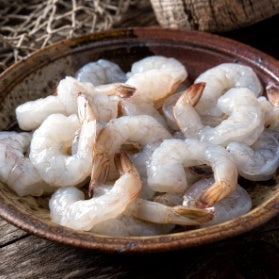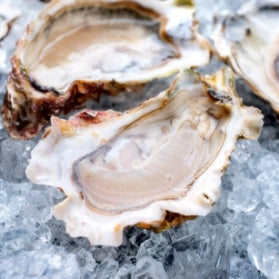Your Cart is Empty
FREE SHIPPING ON ALL ORDERS OVER $125!
FREE SHIPPING ON ALL ORDERS OVER $125!
FREE SHIPPING ON ALL ORDERS OVER $125!
When it comes to buying food, you’ve likely heard that fresh is best. However, that isn’t always true!
When discussing frozen fish vs fresh, the former can be equally nutritious and delicious as the fresh alternative. Fish that is properly frozen at the peak of freshness can maintain its optimal quality, texture, and flavor, oftentimes rivaling that of fresh or previously frozen fish.

Fresh doesn’t inherently equate to superior quality, just like frozen doesn't always mean inferior quality. There is a lot that can happen between the time of catch, the time you are purchasing at the store , and the time you are finally cooking in the kitchen. Each step of that process affects the end quality of fresh seafood.
But don’t just take our word for it. Let’s take a closer look at frozen fish vs fresh fish to uncover which is really best.
There’s a common misconception that fresh seafood is more nutritious than frozen. This simply isn’t true.
According to Live Strong, freezing doesn't reduce the nutritional content of fish. That’s because the protein and important vitamins and minerals found in fish aren’t affected by the freezing process.
However, it’s important to note that as frozen fish fillets and shellfish (like shrimp or scallops) thaw they may naturally lose some of their water content. This water can contain some water-soluble vitamins and minerals, but not a lot. While this wouldn’t happen with fresh fish, the nutritional difference is marginal.
Another myth surrounding fresh vs frozen fish is that fresh fish always tastes better. This is certainly not always true. You may be surprised to learn that most consumers actually can’t tell the difference between fresh and frozen seafood, and in many cases actually prefer the latter!
During a blind taste test in a 2019 study, the frozen seafood product was liked as much as — or better than — the fresh. When consumers say that frozen seafood has an unappealing, mushy texture, that likely comes down to improper freezing or thawing technique.
To avoid this happening, you want to thaw frozen seafood in the fridge overnight or in a plastic bag under cool running water – never in warm water or at room temperature.

At the end of the day, “fresh” fish at the grocery store may not always be as fresh as you think. The reality is, unless you live on the coast or near a fishing port, you’re likely not eating truly fresh fish (meaning fish that has never been frozen).
EatingWell explains that while “fresh” fish shouldrefer to fish that has never seen a freezer, this is rarely the case. The word fresh is usually used for simplicity of marketing purposes, and the fresh fish at the counter of your grocery store is most likely stocked with seafood that has been previously frozen.
To fully understand the intricate differences between frozen vs fresh fish, it is essential to consider the complex path of fresh fish from boat to plate. Some factors to consider include:
Here are some key attributes to identify when purchasing fresh seafood at the grocery store:
For many, “frozen seafood” has a negative connotation. This likely stems from the old-fashioned practice of freezing inferior quality fish or fish that was about to go bad. Naturally, this practice results in exceptionally poor-quality fish.
However, advancements in quick freezing technology, or “Flash Freezing”, have made it possible for frozen seafood to retain its natural freshness, texture, and flavor without compromising quality.
When fish is frozen quickly and at extremely low temperatures, it preserves its flavor and texture. All of this is locked in until the moment you’re ready to thaw and prepare it!
Now that we’ve busted the myths about frozen seafood, it’s time to take a closer look at its benefits. As we said before, advancements in how fish is frozen have come a long way! When buying frozen fish, you can do your part to reduce food waste while enjoying a higher degree of confidence and convenience.
Here are a handful of benefits of quality frozen fish.
Nitrogen Flash Freezing (-160° F) used for flash freezing maintains the peak flavor and texture of the seafood in its fresh state.
When you thaw flash-frozen seafood in your kitchen, it is just hours or minutes out of the water in a fresh state. It doesn’t get much fresher than that! Especially if you don’t live near a fish market.
There is an added confidence that your seafood has remained pristine from the moment it was caught and frozen to the moment it is on your plate.
Once you bring fresh seafood home and place it in your refrigerator, the clock starts ticking. You only have 2-3 days to cook that seafood before it spoils, which can be a very stressful and inconvenient experience!
Frozen seafood is an excellent option to have at your disposal in your freezer. Whenever you’re ready to cook, simply thaw, prepare, and enjoy!
We recommend defrosting your fish under refrigeration. Most seafood will thaw completely within 12-24 hours, so just move your frozen fish to the refrigerator the night before you want to cook it and you are golden.
It’s no secret that fresh fish spoils faster than frozen. That’s part of the reason why Eco-Trust found that 23% of seafood at supermarkets goes to waste! And that’s not counting the fresh seafood that consumers bring home and don’t cook in time – ultimately meeting the same fate in the trash.
The experts agree that greater consumer awareness and acceptance of high-quality frozen fish can combat this waste. Simply put, frozen fish lasts longer and is less likely to spoil than fresh alternatives.
Ready to buy frozen seafood with confidence? Having high-quality seafood stocked up in your freezer is an excellent option to have available consistently for those times when fresh seafood is not an option.
North Coast Seafoods offers a variety of fresh and frozen seafood flash-frozen at the peak of freshness. The science behind our flash-freezing technology ensures your seafood has remained pristine from the moment it was caught and frozen to the moment it is on your plate.
Comments will be approved before showing up.



Sign up to receive the best seafood recipes, first access to new products, exclusive discounts and more!